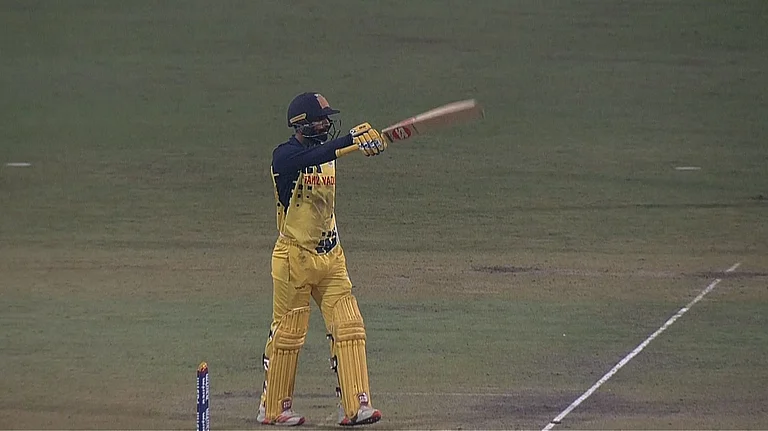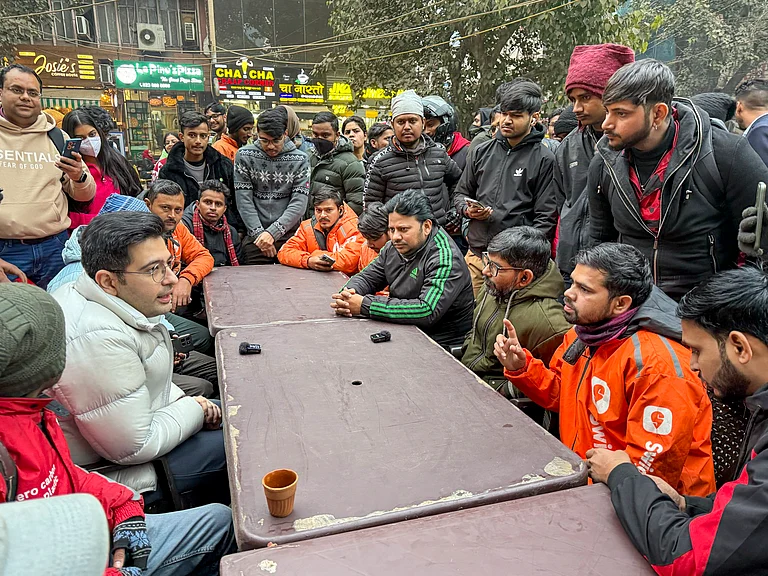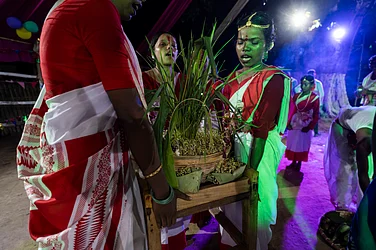Stings and scams are passe by now on Bengal’s roiling political stage, but can an accident ask hard questions of a regime confident it will win a second term? It might be wishful thinking to see part of the under-construction flyover that collapsed in Calcutta’s Girish Park area as a metaphor for the Trinamool Congress’s fortunes in the assembly polls, but the tragedy offered the trifecta of CPI(M), Congress and BJP another chance of a lunge at TMC. Not that it caused even a wrinkle on chief minister Mamata Banerjee’s natural, confident pugnacity: she rushed back from outside Calcutta to manage the defence and promise punishment for the errant firm and compensation for the 21 dead (till going to press) and many injured.
‘Stings’, of course, have flavoured this election season. So much so that two constables of the special branch of Calcutta Police are accused of snooping on politicians and even trying to bribe a BJP leader for helping them smuggle cattle to Bangladesh. While Calcutta police commissioner Rajeev Kumar promptly suspended the two men and the police sought to explain that the accused had approached the BJP’s former state chief Rahul Sinha in their ‘personal’ capacity, both the BJP and the Congress sought Kumar’s removal. They complained to the Election Commission that Kumar took his orders from the ruling party. There is, however, little evidence to suggest that stings and scams make much difference to electoral fortunes in Bengal.
The Saradha chit fund scam, which spread its tentacles during the Left Front regime but exploded into life and notoreity in Mamata Banerjee’s third year in office in 2013, failed to slow down her juggernaut as she mauled rivals in the urban local bodies’ election, in the Lok Sabha polls in 2014 and subsequently in the panchayat polls.
One of Mamata’s trusted lieutenants, Madan Mitra—the prime Trinamool casualty in Saradha—has been in jail for the past year-and-a-half. But while the CBI opposed this influential leader’s bail plea, Mitra has been renominated to contest the election, with his wife and sons braving the heat to campaign on his behalf.

While Mamata, naturally, has explained away the CBI probe into the Saradha scam and arrests made by them as a conspiracy hatched by the Centre, the agency’s slow progress (it has been four years since they took it on) lends some credence to her charge. The message: Mamata won’t be cowed down by a mere CBI inquiry.
Then there was last month’s sting videos by news portal Narada News, which show over a dozen Trinamool stalwarts accepting wads of cash. Mamata treated it with even more contempt—other than the obligatory, reflexive remark that they were ‘false’, TMC had refused to even dignify it with a comment.
Yet, despite palpable desperation in the opposition, despite being buoyed by opinion polls, Mamata is facing one of her toughest electoral challenges. And she is leaving nothing to chance. For the past week she has not budged from Jangalmahal, 350 km from Calcutta, which is going to the polls in the first phase on April 4. On the face of it, she is addressing rallies, meeting voters, highlighting her achievements in bringing peace to the once Maoist-dominated region. But, TMC insiders say, her agenda has been to ensure that party workers do the needful to make the ‘voting machinery’ work in her favour on D-day.
“Mamata knows how to win elections,” explains one. “She is keenly aware that in remote rural regions, it is not about convincing individuals to make an informed choice but about swinging entire support bases of communities. She is here to ascertain that her workers are spreading out and capturing ground at the grassroots.”

The scene at the flyover collapse site
Yet, when Mamata stormed into power in the historic assembly elections of 2011, it was not because she knew how to ‘work the system’. She got hold of the zeitgeist not just because she had endeared herself to the people with her demotic and quirky charisma but because of her promise to bring ‘poriborton’—change—to Bengal. While it was largely a negative vote against the Left Front, Mamata had managed to raise expectations. Notwithstanding her role in driving out the Tatas from Singur, her earlier stints as a central minister, it was hoped, would help her rule better.
Five years down the line, those expectations stand belied in some crucial ways. Mamata has bent backwards to please industrialists, but industry remained unmoved. Salaried jobs are hard to come by while professional courses have proliferated, and graduates have been migrating in hordes. So have been the blue-collared—maids and rickshaw-pullers to New Delhi, masons to Kerala, jewellery workers to Mumbai and diamond-cutters to Surat, waiters to the Mumbai-Pune belt...they are fleeing arid Bengal for any opportunity to make a living.
One of her first—and much ridiculed—acts was an attempt to change ‘West Bengal’ to the more commonly used Bengali ‘Paschimbanga’. More superficial ‘poriborton’ followed. The state government painted state-owned buildings blue and white. The impulsive move, it was alleged, was designed to benefit contractors. Leader of Opposition Suryakanta Mishra quipped, “those are the colours of her chappals”. What caused more outrage was her decision to instal tri-polar streetlamps—with a total outlay of Rs 25 crore—across towns in Bengal, and attracted similar charges.
Her much-touted promise to “turn Calcutta into London” was equally laughed at, but she seems to have succeeded in making cities cleaner. Garbage disposal has improved hugely. Visitors to Calcutta are often struck by the change. “It looks much more beautiful now,” says a Londoner visiting Calcutta after seven years.
But a light-wrapt city hasn’t entirely satisfied the middle class. They did not vote for ‘cosmetic changes’, they grumble. Capital-starved Calcutta has been compared to “a cancer patient crumbling from inside who has been decked up in fine jewellery”. Says Disha Sengupta, who moved back to Calcutta with her husband Akash from the US, “We didn’t want plastic surgery. We wanted a holistic cure. We voted for her and believed in her plans to create jobs, free education from politics etc. We are sorely disappointed.” That’s valid in ways.
Academics said they were alarmed by the way Jadavpur University professor Ambikesh Mahapatra was hauled off to jail after being beaten up by TMC musclemen for circulating a caricature of the CM. “Bengal has been a land of free thinkers, a place where people speak their minds without fear,” says Disha. “Whatever the Left may have been, at least we could criticise and even make fun of the government. But this is frightening. Dictatorships are rearing their ugly heads....” Again, valid critique.
Then, too, people winced at the language she used, language the Bengali bhadralok associated with the gutter. The Telegraph, the city’s top English daily, put up a bamboo screen on the front page when Mamata lashed out at critics who were, she said, busy shoving bamboo sticks up the backside of her partymen (‘pechhone baansh’). Yet, some say such language helped her strike a rapport with the rural populace, although pundits found her public speeches annoyingly rambling and incoherent.
Mamata, with her retinue of Tollywood moviestars, singers, artists and culturati, can be a picture of amiable charm when meeting Amitabh Bachchan or Shahrukh Khan, but wasn’t exactly averse to branding a college student “a Maoist” when she asked the CM uncomfortable questions about the infamous Park Street rape incident. Nor did she hesitate to get a farmer arrested on the same charges for raising his voice against rise in fertiliser prices at a public meeting.
The litany of Mamata’s faux pas is long. Her casual (and not very pro-women) dismissal of the victim’s allegation of rape on Park Street as a ‘concocted story’ was particularly galling (the charge was proved to be correct). She again branded two women as ‘Maoists’ for protesting the rape and murder of their friend in Kamduni, antagonising thousands. “We had felt proud to have a woman CM,” says Leena Chakrabory, a student of Calcutta University. The first-time voter in 2011 had gone with a group of collegemates to “stamp our votes on the ‘joraphool’ (Trinamool’s symbol)”. In five years, they are all “completely disillusioned”.
Yet, Mamata keeps winning elections. In the last five years, she has swept every major poll in the state, including the Lok Sabha polls in 2014 (she bagged 34 of the 42 seats) and the municipal elections in 2015 (she won 70 out of the 92 civic bodies including Calcutta, with the Left Front and Congress getting six and five). Interestingly, she has managed to do so in spite of major scams implicating the TMC surfacing, some of them before the polls.
The chit fund scandal that erupted just before the Lok Sabha polls, entangling the whole of the TMC top brass, including Mukul Roy, Madan Mitra and Kunal Ghosh into it, should have cast a dark cloud over the party’s prospects in rural areas, where thousands had lost their life’s savings. But while the economic conditions of most people continue to be grim, a large number of them also paradoxically continue to vote for her. Why?
Though the question baffles many, some answers aren’t hard to find. Mamata’s government has spent crores on rural infrastructure, especially roads, bridges and electricity, has delivered rice at Rs 2 a kilo to lakhs and has rolled out popular schemes like Kanyashree (meant to empower girls). Ultimately, it is the people of Bengal who hold the key to the answer why.
In the remote Jangalmahal village of Belpahari, a young girl answers “Didi” when asked, “Who will you vote for?” To that, we ask the inevitable counter-question, “Why?” The answer is again pat. “Because she gives us rice.” Her family, village and community—long abandoned by the state—has at last seen a semblance of it. A 50-year-old forest-dweller explains, “Five years ago, we had nothing to eat except fruit from the forest and greens from the fields. Today each family gets 16 kg rice at Rs 2 a kilo every month.” It’s a bounty for those teetering on the edge of starvation. And Mamata, who kickstarted the programme in Jangalmahal, is “a devi, a saviour”. Such measures—‘populism’ for the economist, but a lifeline for people—is at the root of Mamata’s success. Every BPL family the Outlook team visited in urban and rural areas seemed grateful to her. Another hit with the masses is the 100-day work guarantee at Rs 160 a day. Engaging uneducated, unemployed youth for odd jobs (including painting administrative buildings blue and white) has also worked well.
So big industry has eluded Bengal, but at the grassroots some flowers, however small, are blooming. But can this be the only reason for Mamata’s electoral consistency? If not the only key, fear is surely one of the keys to it too. Suman Dey, editor-in-chief of ABP Ananda newschannel, after a poll survey, said survey officials had “noticed a sense of fear among the people they spoke to”. Outlook’s interactions with people revealed a similar reluctance to speak out and criticise the administration or the party. They do seem intimidated by TMC cadre. Former speaker Somnath Chatterjee told Outlook, “There is such fear of physical violence against political rivals that for long Left leaders were scared to come out.”
Techniques of control over the social and political realms dating from the days of the Left’s ‘scientific rigging’ have evidently matured. No wonder, after TMC came to power, an enervating lethargy had seemed to grip the opposition. During the civic polls of 2015, which were so sanguinary that the state electoral commissioner conceded they may not have been completely ‘free and fair’, several constituencies won by TMC had gone uncontested.
Debates over whether political violence visited on rivals is a legacy of the Left miss a key point about her character. The thing is, Mamata hasn’t just inherited the knowhow of how to ‘work the system’ but has mastered the useful art of doggedly defending hard-won power by all means available. Some observers suggest her unchallenged power in Trinamool has worked in her favour. She is the one who has the final word on crucial issues. But outside of that, she seems to have allowed both ministers and bureaucrats a certain degree of freedom. And they seem to have performed marginally better, say these observers, than during the Left Front days as they know the mercurial, often irascible, Mamata would hold them accountable. Also, to be sure, the quality of her ‘helmswomanship’ is a tad different from that of Jayalalitha and Mayawati, whose parties have no other faces at all.
So the terms in which West Bengal debates whether (and what) Mamata has or has not delivered in the last five years are different from how outsiders read things. Whimsical? Totalitarian? Welfarist? More Left than Left? It’s Bengal’s vote.
***
The Good, The Bad & The Ugly
Life in Bengal’s capital may have improved, but vital parameters—including law and order—governing countless lives have worsened
Improved
Civic services (garbage disposal systems have improved dramatically; roads are regularly swept, washed, cleaned)
Electricity supply
Roads
Populist measures
- Rice @ Rs 2 a kilo for households below poverty line
- Grant of Rs 2,000 per month to select BPL houses
- Successful implementation of NREGA to give employment for 100 days a year @ Rs 120 a day
- Bicycles to girl students
- Generous grants to ‘clubs’ manned by party workers
Worsened
- Police The trust deficit between police and the people is at an all-time low. Politicised during the Left Front rule, police now appears totally subservient to workers of the ruling party.
- Law and order Always susceptible to mob violence and political violence, the general law and order in the state has taken a plunge, with violence against women and campus violence rising sharply. Police has been markedly reluctant to take action against ruling partymen guilty of inciting mobs.
- Employment/Industry Having driven out the Tatas from Singur and the Salim Group of Indonesia from Nandigram while in opposition, Mamata has been unable to rebuild trust with industry barons. Her stand on not alienating agricultural land also came in the way of creating jobs.
- EducationThe Left Front had filled colleges and universities with party loyalists and activists. Replacing them being a slow and long process, Mamata Banerjee and her party have resorted to interfering directly in admission and appointments.
- Extortion industry Extortion from trucks, buses and contractors had become an organised industry under the Left Front. Now it is much more brazen, unorganised and therefore even more menacing.
Claimed
- The state government says it has a land bank of one lakh acres
- A handful of IT companies and cement plants have come up
- Tax collections doubled due to administrative measures
Mamata’s Captives
- Muslims constitute 27% of the state’s population
- 65 out of 341 blocks have a Muslim majority
- 80% of Muslim households rural
- Three-fourth of Muslim households have income of Rs 5,000 or less
- 47% of Muslims are agricultural workers or daily-wage earners
Source: Census, ‘Living Reality’ report compiled by Pratichi Trust and 47th report of the Commissioner of Linguistic Minorities
***
Who Will Have The Last Laugh?

Suryakanta Mishra, CPI(M)
CPI(M) politburo member and Leader of Opposition in the state assembly, the former health minister leads the charge for the Left Front. Having held important portfolios in the Left Front regime, including health, land and land reforms, panchayat and rural development, the taciturn leader is known for his integrity and his sardonic wit. A medical graduate from Utkal University, Mishra has authored books on land reforms, alternative development and panchayats besides being a medical volunteer during the 1971 war.

Mohammed Salim, CPI(M)
The CPI(M) politburu member and one of the only two CPI(M) candidates to win a parliamentary seat in 2014, the 57-year-old is one of the most vocal and visible members in the Lok Sabha. A sizeable section of the Congress and the Left Front were in favour of projecting him as a chief ministerial candidate of the alliance. “Projecting Salim as the chief ministerial candidate will swing the 27 per cent Muslim votes in favour of the Left-Congress alliance,” claimed a CPI(M) leader.

Chandra Kumar Bose, BJP
The grandnephew of Netaji Subhas Chandra Bose has been fielded by the BJP against the CM. Some in the BJP believe the suave and urbane Bose—member of one of Bengal’s prominent families—would do well when pitched against the shrill and often incoherent Mamata in her south Calcutta constituency. Though detractors have suggested that even at 6-foot-one he is no match to the 5-foot-one Didi, other pundits claim that the economics graduate from London, being a Netaji lookalike, is a hit with the Bengali bhadralok.

Roopa Ganguly, BJP
The former actress, once dismissed as a lightweight, is said to be the dark horse, giving Mamata a run for her money by exhibiting unexpected crowd-pulling powers. The 52-year-old, who, some claim, is emulating Mamata—visiting homes, talking with women, sipping tea, listening to their problems—has star appeal as an additional advantage. Critics who disparagingly frowned on her acting career have been silenced with the counter question. “If Jayalalitha can, why can’t she?”
By Dola Mitra in Calcutta


























